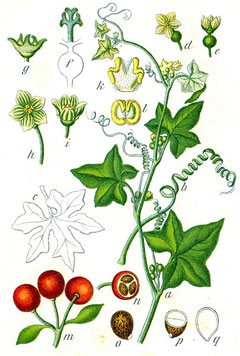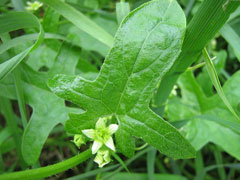 |
|
http://commons.wikimedia.org/wiki/File:Bryonia_dioica_Sturm64.jpg |
 |
| http://de.wikipedia.org/wiki/Benutzer:Botaurus |
Translate this page:
Summary
Physical Characteristics

 Bryonia dioica is a PERENNIAL CLIMBER growing to 3.5 m (11ft) by 3 m (9ft) at a fast rate.
Bryonia dioica is a PERENNIAL CLIMBER growing to 3.5 m (11ft) by 3 m (9ft) at a fast rate.
See above for USDA hardiness. It is hardy to UK zone 6. It is in flower from May to June. The species is dioecious (individual flowers are either male or female, but only one sex is to be found on any one plant so both male and female plants must be grown if seed is required). and is pollinated by Bees. The plant is not self-fertile.
Suitable for: light (sandy), medium (loamy) and heavy (clay) soils and prefers well-drained soil. Suitable pH: neutral and basic (mildly alkaline) soils. It can grow in semi-shade (light woodland) or no shade. It prefers moist soil.
UK Hardiness Map
US Hardiness Map
Synonyms
B. cretica dioica. (Jacq.)Tutin.
Plant Habitats
Woodland Garden Dappled Shade; Hedgerow;
Edible Uses
Edible Parts: Leaves Shoots
Edible Uses:
Young shoots - must be cooked[2, 105]. They are eaten in spring. Caution is advised in the use of this plant, see the notes above regarding toxicity.
References More on Edible Uses
Medicinal Uses
Plants For A Future can not take any responsibility for any adverse effects from the use of plants. Always seek advice from a professional before using a plant medicinally.
Cathartic Cytotoxic Diaphoretic Expectorant Hydrogogue Irritant Pectoral Purgative
Vermifuge
A powerful cathartic and purgative, bryony is used with great caution in present-day herbalism[254]. It is primarily prescribed for painful rheumatic conditions[254]. The root is cathartic, cytotoxic, diaphoretic, expectorant, hydrogogue, irritant, pectoral, purgative and vermifuge[4, 9, 19, 21, 46, 165]. It is used in small quantities internally in the treatment of various inflammatory conditions, bronchial complaints, asthma, intestinal ulcers, hypertension and arthritis[238]. Externally, it is applied as a rubefacient to muscular and joint pains and pleurisy[238]. The root, which can be 75cm long and 75mm thick[268], can be used fresh at any time of the year[7], it can also be harvested in the autumn and be dried for later use[4]. This plant should be used with great caution and only under the supervision of a qualified practitioner. See the notes above on toxicity. The whole herb has an antiviral effect[254].
References More on Medicinal Uses
The Bookshop: Edible Plant Books
Our Latest books on Perennial Plants For Food Forests and Permaculture Gardens in paperback or digital formats.

Edible Tropical Plants
Food Forest Plants for Hotter Conditions: 250+ Plants For Tropical Food Forests & Permaculture Gardens.
More

Edible Temperate Plants
Plants for Your Food Forest: 500 Plants for Temperate Food Forests & Permaculture Gardens.
More

More Books
PFAF have eight books available in paperback and digital formats. Browse the shop for more information.
Shop Now
Other Uses
References More on Other Uses
Cultivation details
A rapid grower, it is of easy cultivation succeeding in most soils that are well drained[1], avoiding acid soils in the wild[17]. Prefers a sunny position[238]. A very deep-rooted climbing plant[7], attaching itself to other plants by means of tendrils[4]. The plant is not eaten by rabbits[17]. Plants can be easily encouraged by scattering ripe seed along the base of hedgerows[200]. Dioecious, male and female plants must be grown if seed is required[200].
References Carbon Farming Information and Carbon Sequestration Information
Temperature Converter
Type a value in the Celsius field to convert the value to Fahrenheit:
Fahrenheit:
The PFAF Bookshop
Plants For A Future have a number of books available in paperback and digital form. Book titles include Edible Plants, Edible Perennials, Edible Trees,Edible Shrubs, Woodland Gardening, and Temperate Food Forest Plants. Our new book is Food Forest Plants For Hotter Conditions (Tropical and Sub-Tropical).
Shop Now
Plant Propagation
Seed - best sown as soon as it is ripe in a cold frame. Sow stored seed in late winter in a cold frame. When large enough to handle, prick the seedlings out into individual pots and grow them on in the greenhouse for at least their first winter, planting them out into their permanent positions in late spring or early summer, after the last expected frosts. Division in early spring.
Other Names
If available other names are mentioned here
Native Range
EUROPE: Denmark, United Kingdom, Austria, Belgium, Switzerland, Czech Republic, Germany, Hungary, Netherlands, Slovakia, Albania, Bulgaria, Croatia, Italy (incl. Sicily), Montenegro, Slovenia, Spain, France, Portugal AFRICA: Algeria, Morocco, Tunisia
Weed Potential
Right plant wrong place. We are currently updating this section.
Please note that a plant may be invasive in one area but may not in your area so it's worth checking.
Conservation Status
IUCN Red List of Threatened Plants Status :

Growth: S = slow M = medium F = fast. Soil: L = light (sandy) M = medium H = heavy (clay). pH: A = acid N = neutral B = basic (alkaline). Shade: F = full shade S = semi-shade N = no shade. Moisture: D = dry M = Moist We = wet Wa = water.
Now available:
Food Forest Plants for Mediterranean Conditions
350+ Perennial Plants For Mediterranean and Drier Food Forests and Permaculture Gardens.
[Paperback and eBook]
This is the third in Plants For A Future's series of plant guides for food forests tailored to
specific climate zones. Following volumes on temperate and tropical ecosystems, this book focuses
on species suited to Mediterranean conditions—regions with hot, dry summers and cool, wet winters,
often facing the added challenge of climate change.
Read More
Expert comment
Author
Jacq.
Botanical References
17200
Links / References
For a list of references used on this page please go here
Readers comment
| Add a comment |
|
If you have important information about this plant that may help other users please add a comment or link below. Only comments or links that are felt to be directly relevant to a plant will be included. If you think a comment/link or information contained on this page is inaccurate or misleading we would welcome your feedback at [email protected]. If you have questions about a plant please use the Forum on this website as we do not have the resources to answer questions ourselves.
* Please note: the comments by website users are not necessarily those held by PFAF and may give misleading or inaccurate information.
To leave a comment please Register or login here All comments need to be approved so will not appear immediately.
|
|